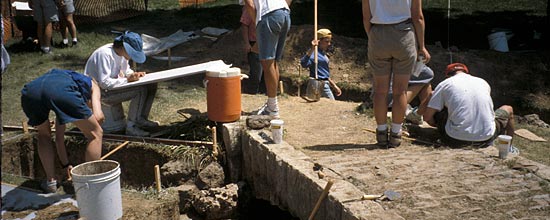

Guidelines for Restoring Cultural Landscapes
Water Features

Identify, Retain, and Preserve Historic Features and Materials from the Restoration Period
![]()
Identifying, retaining and preserving existing water features and water sources such as retention ponds, pools, and fountains from the restoration period prior to project work. Documenting shape, edge and bottom condition/ material; water level, movement, sound and reflective quality; associated plant and animal life, and water quality.
Evaluating the condition of water features from the restoration period. For example, assessing water quality or utilizing archeological techniques to determine the path of a watercourse.
![]()
Executing project work that impacts water features and associated hydrology from the restoration period, without undertaking an “existing conditions” survey. For example, filling in a pond that was historically used for ornamental or farming purposes.
Executing project work without understanding its impact on water features from the restoration period. For example, placing a section of creek in a culvert or concrete channel.
Protect and Maintain Features and Materials from the Restoration Period
![]()
Protecting and maintaining water features from the restoration period by use of non-destructive methods in daily, seasonal and cyclical tasks. For example, cleaning leaf litter or mineral deposits from drainage inlets or outlets.
Maintaining a water feature’s mechanical, plumbing and electrical systems to insure appropriate depth of water or direction of flow. For example, routinely greasing and lubricating gate mechanisms for a pond.
![]()
Failing to undertake preventive maintenance of water features from the restoration period. For example, allowing a historic fish pond to fill up with leaf litter.
Utilizing maintenance methods which destroy or degrade water features from the restoration period. For example, using harsh chemical additives for maintaining water quality.
Allowing mechanical systems to fall into a state of disrepair, resulting in changes to the water feature. For example, failing to maintain a sprinkler system on a historic golf course.
Repair Features and Materials from the Restoration Period
![]()
Repair deteriorated water features from the restoration period by reinforcing the materials that comprise these features. Repairs will generally include limited replacement, in-kind or compatible substitute material, of those extensively deteriorated or missing parts of features when there are surviving prototypes. For example, replacing in-kind corroding iron valves in a historic spray pool. The new work should be unobtrusively dated to guide future research and treatment.
![]()
Replacing or destroying water features from the restoration period when repair of materials and limited replacement of deteriorated or missing parts are appropriate. For example, filling in a historic farm pond instead of removing invasive plant materials.
Using a substitute material for the replacement part that does not convey the visual appearance of the surviving parts of the water feature from the restoration period, or is physically or environmentally incompatible. For example, replacing marble coping stone with concrete.
Replace Extensively Deteriorated Features from the Restoration Period
![]()
Using existing physical evidence of form, depth and detailing to reproduce an entire water feature from the restoration period. If using the same kind of material is not technically, economically, or environmentally feasible, then a compatible substitute material may be considered. The new work should be unobtrusively dated to guide future research and treatment. For example, replacing a granite watering trough with one of cast stone.
![]()
Removing a water feature from the restoration period that is unrepairable and not replacing it; replacing it with a new feature that does not convey the same visual appearance; or failing to document the new work. For example, channeling a natural stream into a culverted pipe.
Remove Existing Features from Other Historic Periods
![]()
Removing or altering water features from other historic periods. For example, removing a modern retention pond.
Documenting water features from other periods prior to their alteration or removal. For example, inventorying and cataloguing hydrology, flora and fauna associated with the feature. If possible, selected examples of these materials or features should be stored to facilitate future research.
![]()
Failing to remove water features from another period, thus confusing the depiction of the landscape during the restoration period. For example, maintaining a swimming pool on the site of an historic herb garden.
Failing to document water features from other historic periods that are removed or altered so that a valuable portion of the historic record is lost.
Re-Create Missing Features from the Restoration Period
![]()
Recreating a missing water feature that existed during the restoration period based on historical, pictorial and physical documentation. For example, recasting a fountain from its original mold.
![]()
Constructing a water feature that was thought to have existed during the restoration period, but for which there is insufficient information; or constructing a water feature that was part of the original design but was never executed, thus creating a false historic appearance.
At the Joslyn Castle in Omaha, Nebraska, the location of pools believed to be part of the original design by Jens Jensen was confirmed by archeology. (Mary Hughes)